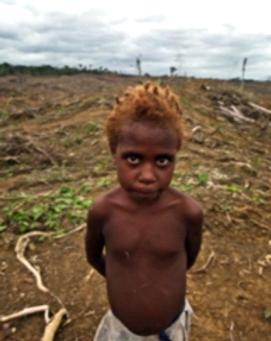Schuster Institute for Investigative Journalism
at Brandeis University
i n v e s t i g a t i o n s
































































Our investigation reveals that some palm oil--the most widely used vegetable oil in the world--is produced with slave labor. Palm oil is in all the products above, and many more.
Palm Oil Controversies
The Abuse:
Indigenous Peoples' Rights
The palm oil industry has brought great new wealth to Indonesia and neighboring Malaysia. But not everyone is experiencing the resulting prosperity.
Indigenous People in Indonesia
In Indonesia, “indigenous peoples” are defined loosely as isolated communities as well as people whose rights to their land are dictated by custom or heritage. Between 60 and 120 million Indonesians are currently considered “indigenous” out of a total 250 million people, and hold informal or customary tenure to more than 60% of land holdings in Indonesia.
Land Rights
Traditional land tenure rights, while recognized at the community level, may not be recognized by the state, however, and have not held up against pressure from corporate interests to acquire large tracts of land for agriculture.
A Time news report indicates there were 2,791 land disputes in 2011, per Indonesia's National Land Agency. The Time report says the "National Commission on Human Rights received 4,502 complaints of rights abuses, with 738 stemming from land disputes."
According to the Forest Peoples Programme, “the Basic Forestry Law of 1967 and the revised Forestry Law of 1999 claim State ownership over all forests in Indonesia without sufficient consideration of customary rights and local traditions.” While the Indonesian Constitution protects indigenous’ peoples’ customary ownership to their lands, and Indonesia voted to approve the UN Declaration of the Rights of Indigenous Peoples, experts believe "a lack of congruency between customary systems of land ownership and inheritance and the legal system as interpreted by the Government underlies the disputes between the indigenous peoples and Government-permitted developers."
Only 0.2% of Indonesia’s national forest territory has been legally allocated to the various indigenous communities living there, according to World Agroforestry Centre data reported in "Palm Oil & Indigenous Peoples in South East Asia." Legal loopholes, confusing legislation, and enthusiastic support for large-scale corporate plantation development from the government have allowed large palm corporations to take over local peoples’ land for as little as $1 a hectare, often without indigenous communities’ full understanding of the deal.
Prompted by pressure from the United Nations and civil society against the mistreatment of its rural peoples, the Indonesian government has recently attempted to further clarify its laws to give indigenous landowners more rights and protect them against corporate interests—most notably in its 2007 Company Law, which requires that companies doing business in natural resources must meet their social and environmental responsibilities. While stronger legal protections are being implemented at the state level, experts for the Forest Peoples Programme say Indonesia's capacity to enforce them is weak.
Indigenous communities have taken a stand against what they believe are injustices incurred by developers and the state. Public protests and demonstrations by indigenous people against palm oil plantations have devolved into violence and police brutality.
In the meantime, efforts are underway to improve planning methodologies that include and benefit local inhabitants who are affected by oil palm plantation and other natural resources developments. And in an effort to curb violence and aid development, the Jakarta Globe says the House of Representatives in Indonesia is pressing to update the 1960 Agrarian Law and make land-use concessions more proportionate between developers and local communities.
Earlier this year, East Kalimantan Governor Awang Faroek Ishak told Reuters he was imposing a one year ban on "new permits on forestry, mining and plantation" aimed at curbing mining and palm oil expansion and cutting back on land disputes.
Land rights is the focus of "Greasy Palms: The Impacts of Indonesia's Palm Oil Plantations," (below) a documentary produced by the Paradigm Shift Project. Through interviews with residents, including women, the filmmakers document the effects new oil palm developments have had on the indigenous Pergula'an and other local communities of Indonesia.
Above, Sekonyer community members watch as an excavator tears down trees and digs a drainage canal in preparation for new plam oil plantations in one of the last areas of natural forest remaining in the buffer zone of the Tanjung Puting National Park.
Inset photo: Girls huddle on a raft amid smoke from a raging forest fire.
Palm Oil Billionaire Is Newcomer to Forbes Richest
Indonesians

In July 2013, the net worth of Indonesia's richest was $88.6 billion, up 4% from last year, and includes Lim Hariyanto Wijaya Sarwono, one of four newcomers in 2012 to Forbes' annual list of the wealthy. Lim's plantation outfit, Bumitama Agri, is listed in the Singapore stock exchange.
See the full list of Indonesia's richest citizens.
Further Reading
"Exploitative Labor Practices in the Global Palm Oil Industry," Accenture, 2013.
“The oil palm industry: A road to poverty reduction,” Philippine Daily Inquirer, February 18, 2013.
“Palm oil and indigenous peoples in South East Asia,” Forest Peoples Programme and the International Land Coalition, January 17, 2011.
“Land is life: Land rights and oil palm development in Sarawak,” Forest Peoples Programme, November 5, 2011.
“Social Conflicts – Inequity and Rights Abuses,” Sawit Watch, July 26, 2011.
“Oil Palm Expansion in Southeast Asia: Trends and implications for local communities and indigenous peoples,” Forest Peoples Programme and Sawit Watch, November 18, 2011.
Next: The Environment
In Indonesia's West Papua, indigenous people are hurt by timber and oil palm developments, according to this film clip published at The Guardian.
Photo | Rainforest Action Network
Inset photo: Greenpeace
On this page
Indigenous people in Indonesia
Land rights
FILM: "Greasy Palms"
by Paradigm Shifts
Further reading
Links to other sections
1. Forced Labor on
Palm Oil Plantations
2. From Palm Fruit
to Product
3. Human Rights Abuses & Other Controversies
1 | Forced labor & child labor
2 | Indigenous peoples' rights <


